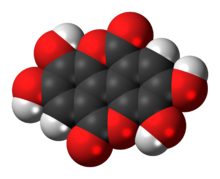حمض الإيلاجيك

| |

| |
| الأسماء | |
|---|---|
| اسم أيوپاك
2,3,7,8-Tetrahydroxy-chromeno[5,4,3-cde]chromene-5,10-dione
| |
| أسماء أخرى
4,4′,5,5′,6,6′-Hexahydroxydiphenic acid 2,6,2′,6′-dilactone
| |
| المُعرِّفات | |
| رقم CAS | |
3D model (JSmol)
|
|
| ChEBI | |
| ChEMBL | |
| ChemSpider | |
| DrugBank | |
| ECHA InfoCard | 100.006.827 |
| KEGG | |
PubChem CID
|
|
| UNII | |
CompTox Dashboard (EPA)
|
|
| |
| |
| الخصائص | |
| الصيغة الجزيئية | C14H6O8 |
| كتلة مولية | 302.197 گ/مول |
| الكثافة | 1.67 گ/سم |
ما لم يُذكر غير ذلك، البيانات المعطاة للمواد في حالاتهم العيارية (عند 25 °س [77 °ف]، 100 kPa). | |
| مراجع الجدول | |
حمض الإيلاجيك Ellagic acid، هو فينول طبيعي مضاد للأكسدة يوجد في العديد من الفواكه والخضروات. خصائص الركود الخلوي والخصائص المقاومة للأكسدة التي يتمتع بها حمض الإيلاجيك دفعت إلى البحث في فوائده الصحية المحتملة. تم تسويقه باحتيال على أن له قدرة على الوقاية وعلاج عدد من الأمراض البشرية، ومنها السرطان، لكن لم يتم إثبات هذه المزاعم.[1][2]
. . . . . . . . . . . . . . . . . . . . . . . . . . . . . . . . . . . . . . . . . . . . . . . . . . . . . . . . . . . . . . . . . . . . . . . . . . . . . . . . . . . . . . . . . . . . . . . . . . . . . . . . . . . . . . . . . . . . . . . . . . . . . . . . . . . . . . . . . . . . . . . . . . . . . . . . . . . . . . . . . . . . . . . .
الأيض
التاريخ
أكتشفه لأول مرة الكيميائي هري براكونوت عام 1831.[3] قام ماكسيمليان نايرنشتاين بتحضير هذه المادة من algarobilla، dividivi, oak bark, pomegranate, myrabolams، وvalonea عام 1905.[3] أقترح أيضاً تحضيره من گلاسين-الگالويل بواسطة الپنسليوم in 1915.[4] كان لوڤه أول شخص ينتج حمض الإيلاجيك اصنطاعياً بتسخين حمض الجاليك مع حمض الزرنيخ أو أكسيد الفضة.[3] [5]
التواجد الطبيعي
يوجد حمض الإيلاجيك في أنواع السنديان مثل السنديان الأبيض الأمريكي الشمالي (Quercus alba) والسنديان الأحمر الأوروپي (Quercus robur).[6]
Myriophyllum spicatum macrophyte يُنتج حمض الإيلاجيك.[7]
حمض الإيلاجيك قد يوجد في الفطر الطبي Phellinus linteus.[8]
في الأغذية
يوجد حمض الإيلاجيك بمستويات مرتفعة في العليق، العنبية حادة الخباء، البقان، الرمان، توت العليق، الفراولة، الجوز، العوسج، والعنب.[9] يوجد أيضاً في الخوخ[10] وأغذية نباتية الأخرى.
المذاحب الطبية والأبحاث
لحمض الإيلاجيك عدد من خصائص الركود الخلوي والخصائص المقاومة للأكسدة في عدد من الاجراءات المعملية والنماذج الحيوانية الصغيرة.[11][12] خصائص الركود الحيوي لحمض الإيلاجيك قد ترجع لقدرته على التثبيط الغير مباشر لارتباط الدنا ببعض المسرطنات، ومنها النتروماسين[13][14] والهيدروكربونات العطرية متعددة الحلقات.[15] مثل مضادات الأكسدة متعددة الفينول الأخرى، فلحمض الإيلاجيك تأثير على النماذج الخلوية بتقليل الضغط المؤكسد.[9]
يسوق حمض الإيلاجيك كمكمل غذائي مع مجموعة من الفوائد المزعومة كمضاد للسرطان، أمراض القلب، والمشكلات الصحية الأخرى. حسب ادارة الغذاء والدواء الأمريكية فحمض الإيلاجيك هو "علاج وهمي للسرطان ينبغي تجنبه".[2] حصل عدد من بائعي المكملات الغذائية بالولايات المتحدة على رسائل تحذير من ادارة الغذاء والدواء من ترويج حمض الإيلاجيك بدعوى اختراق القانون الفدرالي للأغذية، الأدوية، ومستحضرات التجميل.[16][17]
انظر أيضاً
المصادر
- ^ خطأ استشهاد: وسم
<ref>غير صحيح؛ لا نص تم توفيره للمراجع المسماةacs - ^ أ ب 187 Fake Cancer 'Cures' Consumers Should Avoid, from the U.S. Food and Drug Administration. Accessed June 17, 2008.
- ^ أ ب ت Grasser, Georg (1922). Synthetic Tannins. F. G. A. Enna. ISBN 9781406773019.
- ^ Nierenstein, M (1915). "The Formation of Ellagic Acid from Galloyl-Glycine by Penicillium". The Biochemical journal. 9 (2): 240–4. PMC 1258574. PMID 16742368.
- ^ Löwe, Zeitschrift für Chemie, 1868, 4, 603
- ^ Mämmelä, Pirjo; Savolainen, Heikki; Lindroos, Lasse; Kangas, Juhani; Vartiainen, Terttu (2000). "Analysis of oak tannins by liquid chromatography-electrospray ionisation mass spectrometry". Journal of Chromatography A. 891 (1): 75–83. doi:10.1016/S0021-9673(00)00624-5. PMID 10999626.
- ^ Nakai, S (2000). "Myriophyllum spicatum-released allelopathic polyphenols inhibiting growth of blue-green algae Microcystis aeruginosa". Water Research. 34 (11): 3026. doi:10.1016/S0043-1354(00)00039-7.
- ^ Lee YS; Kang YH; Jung JY; et al. (October 2008). "Protein glycation inhibitors from the fruiting body of Phellinus linteus". Biological & Pharmaceutical Bulletin. 31 (10): 1968–72. doi:10.1248/bpb.31.1968. PMID 18827365.
{{cite journal}}:|first10=missing|last10=(help); Unknown parameter|author-separator=ignored (help)[dead link] - ^ أ ب D. A. Vattem and K. Shetty (2005). "Biological Function of Ellagic Acid: A Review". Journal of Food Biochemistry. 29 (3): 234–266. doi:10.1111/j.1745-4514.2005.00031.x.
- ^ Postharvest sensory and phenolic characterization of ‘Elegant Lady’ and ‘Carson’ peaches. Rodrigo Infante, Loreto Contador, Pía Rubio, Danilo Aros and Álvaro Peña-Neira, Chilean Journal Of Agricultural Research, 71(3), July–September 2011, pages 445-451 (article)
- ^ Seeram NP; Adams LS; Henning SM; et al. (June 2005). "In vitro antiproliferative, apoptotic and antioxidant activities of punicalagin, ellagic acid and a total pomegranate tannin extract are enhanced in combination with other polyphenols as found in pomegranate juice". J. Nutr. Biochem. 16 (6): 360–7. doi:10.1016/j.jnutbio.2005.01.006. PMID 15936648.
{{cite journal}}: Unknown parameter|author-separator=ignored (help) - ^ Narayanan BA, Geoffroy O, Willingham MC, Re GG, Nixon DW (March 1999). "p53/p21(WAF1/CIP1) expression and its possible role in G1 arrest and apoptosis in ellagic acid treated cancer cells". Cancer Lett. 136 (2): 215–21. doi:10.1016/S0304-3835(98)00323-1. PMID 10355751.
{{cite journal}}: CS1 maint: multiple names: authors list (link) - ^ Madal, Shivappurkar, Galati, and Stoner (1988). "Inhibition of N-nitrosobenzymethylamine metabolism and DNA binding in cultured rat esophagus by ellagic acid". Carcinogenesis. 9 (7): 1313–1316. doi:10.1093/carcin/9.7.1313. PMID 3383347.
{{cite journal}}: CS1 maint: multiple names: authors list (link) - ^ Mandal and Stoner; Stoner, GD (1990). "Inhibition of N-nitrosobenzymethylamine-induced esophageal tumorigenesis in rats by ellagic acid". Carcinogenesis. 11 (1): 55–61. doi:10.1093/carcin/11.1.55. PMID 2295128.
- ^ Teel, Babcock, Dixit, and Stoner (1986). "Ellagic acid toxicity and interaction with benzo[a]pyrene and benzo[a]pyrene 7,8-dihydrodiol in human bronchial epithelial cells". Cell Biol. Toxicol. 2 (1): 53–62. doi:10.1007/BF00117707. PMID 3267445.
{{cite journal}}: CS1 maint: multiple names: authors list (link) - ^ Warning Letter sent to Millennium Health by the United States Food and Drug Administration, dated May 21, 2008.
- ^ Warning Letter sent to Kenton Campbell at Prime Health Direct, Ltd. by the United States Food and Drug Administration dated July 2, 2007.
وصلات خارجية
- A Food-Based Approach to the Prevention of Gastrointestinal Tract Cancers - video lecture dedicated mainly to ellagic acid. Read by Dr. Gary D. Stoner from the Ohio State University Comprehensive Cancer Center.
- Polyphenols as cancer chemopreventive agents, J. Cell Biochem Suppl. 1995'22:169-80
